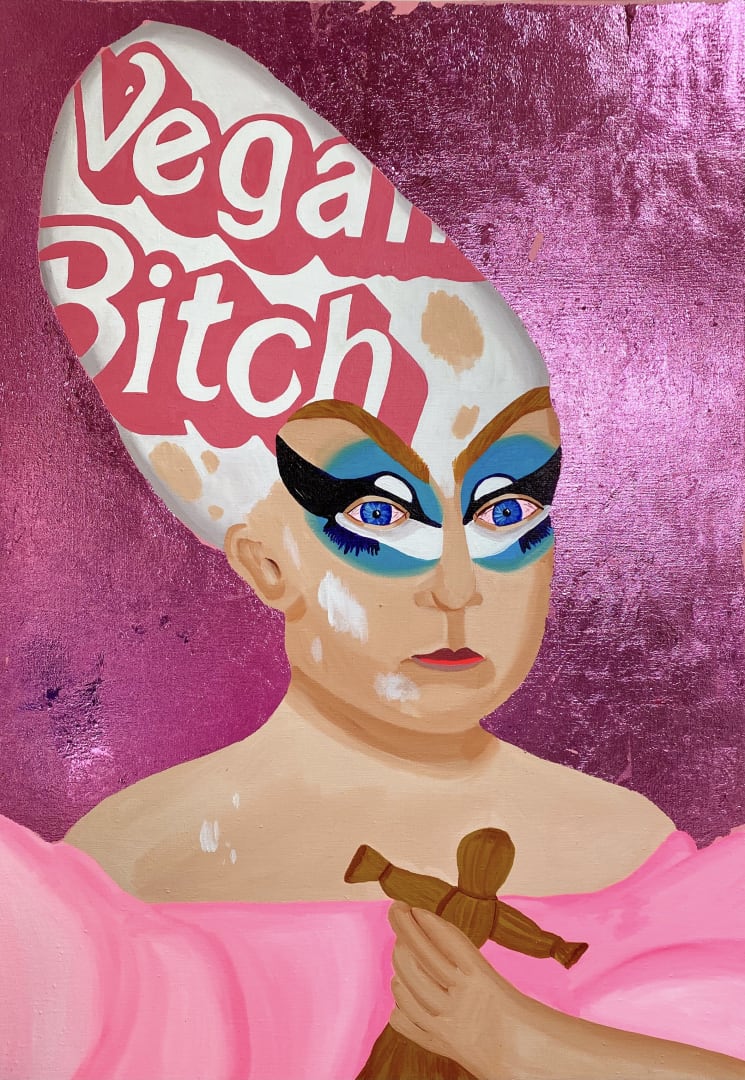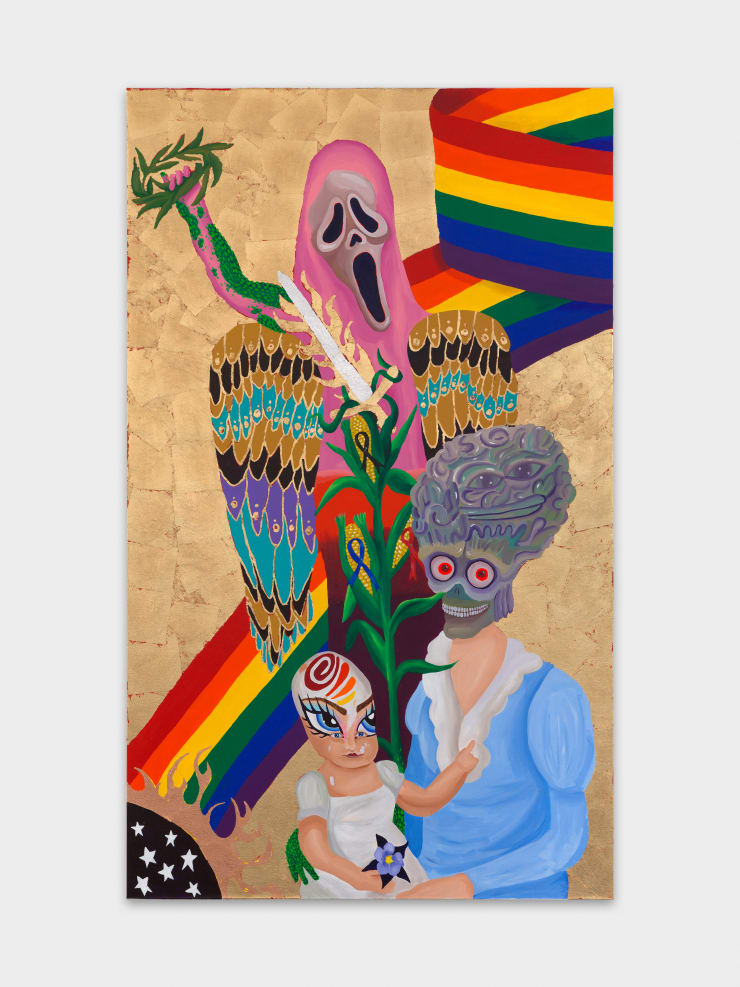The Flesh Failures: Bailey Scieszka
Many American artists of the early 19th century are called "pioneer", "primitive", or “folk”. These artists were of varied backgrounds, mixed lineage and mixed aesthetic traditions, pragmatic and resourceful and, most importantly, highly mobile. Many of them, like Ammi Phillips (1788-1865), traveled throughout the young United states, capturing the age, sex, and social status of their subjects. Following a centuries’ old limner tradition, their world was even characterized as “bizarre neomedievalism”. This two-word combination is a definitional gift for discussing Bailey Scieszka’s paintings and drawings.
Scieszka discovered Phillips’s paintings via art and auction catalogues that she bought at estate sales. She learned how Phillips not only emphasized those things that his patrons considered important, but also how his works were under constantreconstruction, “evolving as he added or discarded what he found successful, while taking care to add personal details that spoke to the identity of those who hired him.” As Stacy Hollander wrote
Phillips showed an early ability to fulfill the narrative elements mandated by portraiture before the age of photography, but interpreted the expected conventions through unusual choices of colors and atypical compositions.
Originality was not essential to a successful painting. Settings, props, costumes, and poses were often borrowed from other sources. Phillips’s works are spare, but revealing, visual collages.
A few years ago, Scieszka created a project in Los Angeles—Soul Dolphin—at Park View / Paul Soto. It drew upon iconic 19th century American portraiture. It was her variety of “bizarre neomedievalism” at the intersection of fantasy and history, albeit American, rooted in the cultural, social, and political turmoil of the Trump era. Then, as now, Scieszka appropriated “pioneer” American portraiture, repainting persons and personalities, using commercial and fantastical imagery, creating new, almost unimaginable characters.
The exhibition’s title was taken from signature song of the 1967 musical Hair: Aquarius / Let the Sunshine In (The Flesh Failures). Scieszka’s paintings and drawings, like the song, are paradoxical illustrations of joy and escape and pain and loss. Unlike the current, but hopefully waning trend, of Disney-meets- Magritte, saccharin-sweet surrealism, Scieszka’ paintings are deliciously unconventional. She draws, paints, collages and, even, decorates her works like other “pioneer” artists. Herworks are not only reflections of the times, but they also look directly at us, making us laugh and shudder with unease.
c.h.b.p.g.b.l.
-
 Bailey ScieszkaTrixie Mattel Baby with Adidas Face Paint, 2021Acrylic and gold leaf on linen61 x 50.8 cm
Bailey ScieszkaTrixie Mattel Baby with Adidas Face Paint, 2021Acrylic and gold leaf on linen61 x 50.8 cm
24 x 20 in -
 Bailey ScieszkaThe Flesh Failures, 2022Acrylic, silver leaf, rose gold leaf, gold, leaf on linen200.7 x 119.4 cm
Bailey ScieszkaThe Flesh Failures, 2022Acrylic, silver leaf, rose gold leaf, gold, leaf on linen200.7 x 119.4 cm
79 x 47 in -
 Bailey ScieszkaFurby/Girl with Disney Video Face Paint Holding a Shopkins Palm Tree with Little Saint James Themed Dress, 2021Acrylic, gold leaf, dollar bills, lottery tickets and Norman Rockwell print, and Thomas Kinkade prints on linen83.8 x 68.6 x 3.8 cm
Bailey ScieszkaFurby/Girl with Disney Video Face Paint Holding a Shopkins Palm Tree with Little Saint James Themed Dress, 2021Acrylic, gold leaf, dollar bills, lottery tickets and Norman Rockwell print, and Thomas Kinkade prints on linen83.8 x 68.6 x 3.8 cm
33 x 27 x 1 1/2 in -
 Bailey ScieszkaStabbed by Flags, 2021Colored pencil, acrylic paint, and gold leaf on paper66 x 101.6 cm
Bailey ScieszkaStabbed by Flags, 2021Colored pencil, acrylic paint, and gold leaf on paper66 x 101.6 cm
26 x 40 in -
 Bailey ScieszkaRusalka (Freedom from Want), 2020Acrylic, gold leaf, fake currency, dollar bills, fortune cookie fortunes, lottery tickets and Norman Rockwell Poster on linen83.8 x 76.2 x 3.8 cm
Bailey ScieszkaRusalka (Freedom from Want), 2020Acrylic, gold leaf, fake currency, dollar bills, fortune cookie fortunes, lottery tickets and Norman Rockwell Poster on linen83.8 x 76.2 x 3.8 cm
33 x 30 x 1 1/2 in -
 Bailey ScieszkaAshamed Girls Ponies: Sexy Green M&M, 2022Acrylic and gold leaf on linen63.5 x 91.4 x 3.8 cm
Bailey ScieszkaAshamed Girls Ponies: Sexy Green M&M, 2022Acrylic and gold leaf on linen63.5 x 91.4 x 3.8 cm
25 x 36 x 1 1/2 in -
 Bailey ScieszkaGirl with Doll, 2022Acrylic and pink foil on linen73.7 x 101.6 x 3.8 cm
Bailey ScieszkaGirl with Doll, 2022Acrylic and pink foil on linen73.7 x 101.6 x 3.8 cm
29 x 40 x 1 1/2 in -
 Bailey ScieszkaTo Commemorate Her Death, 2022Acrylic, gold leaf, Modge Podge, and glitter on canvas88.9 x 63.5 x 3.8 cm
Bailey ScieszkaTo Commemorate Her Death, 2022Acrylic, gold leaf, Modge Podge, and glitter on canvas88.9 x 63.5 x 3.8 cm
32 x 25 x 1 1/2 in -
 Bailey ScieszkaAshamed Girls Pony #7 (OG Bobby Dolphin Riding a Purple Unicorn), 2021Colored pencil, sequins, plastic gems, acrylic paint, Elmer's glue, Modge Podge, and glitter on paper35.6 x 27.9 cm
Bailey ScieszkaAshamed Girls Pony #7 (OG Bobby Dolphin Riding a Purple Unicorn), 2021Colored pencil, sequins, plastic gems, acrylic paint, Elmer's glue, Modge Podge, and glitter on paper35.6 x 27.9 cm
14 x 11 in -
 Bailey ScieszkaIndigo Children with Cat and Dog Face Paint, 2021Colored pencil, acrylic paint, Elmer's glue, Modge Podge, sequins, plastic gems, and glitter on paper61 x 45.7 cm
Bailey ScieszkaIndigo Children with Cat and Dog Face Paint, 2021Colored pencil, acrylic paint, Elmer's glue, Modge Podge, sequins, plastic gems, and glitter on paper61 x 45.7 cm
24 x 18 in -
 Bailey ScieszkaAshamed Girls Pony, 2021Colored pencil, acrylic paint, Elmer's glue, Modge Podge, and glitter on paper35.6 x 25.4 cm
Bailey ScieszkaAshamed Girls Pony, 2021Colored pencil, acrylic paint, Elmer's glue, Modge Podge, and glitter on paper35.6 x 25.4 cm
14 x 10 in -
 Bailey ScieszkaBaby with Kenny Face Paint, 2021Colored pencil, acrylic paint, Elmer's glue, Modge Podge, and glitter on paper35.6 x 27.9 cm
Bailey ScieszkaBaby with Kenny Face Paint, 2021Colored pencil, acrylic paint, Elmer's glue, Modge Podge, and glitter on paper35.6 x 27.9 cm
14 x 11 in

















